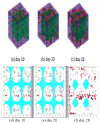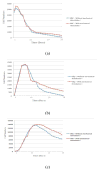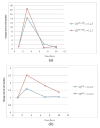Investigation of mechanism of bone regeneration in a porous biodegradable calcium phosphate (CaP) scaffold by a combination of a multi-scale agent-based model and experimental optimization/validation
- PMID: 27460959
- PMCID: PMC10150920
- DOI: 10.1039/c6nr01637e
Investigation of mechanism of bone regeneration in a porous biodegradable calcium phosphate (CaP) scaffold by a combination of a multi-scale agent-based model and experimental optimization/validation
Abstract
Herein, we have developed a novel approach to investigate the mechanism of bone regeneration in a porous biodegradable calcium phosphate (CaP) scaffold by a combination of a multi-scale agent-based model, experimental optimization of key parameters and experimental data validation of the predictive power of the model. The advantages of this study are that the impact of mechanical stimulation on bone regeneration in a porous biodegradable CaP scaffold is considered, experimental design is used to investigate the optimal combination of growth factors loaded on the porous biodegradable CaP scaffold to promote bone regeneration and the training, testing and analysis of the model are carried out by using experimental data, a data-mining algorithm and related sensitivity analysis. The results reveal that mechanical stimulation has a great impact on bone regeneration in a porous biodegradable CaP scaffold and the optimal combination of growth factors that are encapsulated in nanospheres and loaded into porous biodegradable CaP scaffolds layer-by-layer can effectively promote bone regeneration. Furthermore, the model is robust and able to predict the development of bone regeneration under specified conditions.
Figures





Similar articles
-
Modeling vascularized bone regeneration within a porous biodegradable CaP scaffold loaded with growth factors.Biomaterials. 2013 Jul;34(21):4971-81. doi: 10.1016/j.biomaterials.2013.03.015. Epub 2013 Apr 6. Biomaterials. 2013. PMID: 23566802 Free PMC article.
-
PEGylated poly(glycerol sebacate)-modified calcium phosphate scaffolds with desirable mechanical behavior and enhanced osteogenic capacity.Acta Biomater. 2016 Oct 15;44:110-24. doi: 10.1016/j.actbio.2016.08.023. Epub 2016 Aug 17. Acta Biomater. 2016. PMID: 27544808
-
Porous Scaffolds for Regeneration of Cartilage, Bone and Osteochondral Tissue.Adv Exp Med Biol. 2018;1058:171-191. doi: 10.1007/978-3-319-76711-6_8. Adv Exp Med Biol. 2018. PMID: 29691822 Review.
-
Fabrication and in vitro evaluation of 3D printed porous silicate substituted calcium phosphate scaffolds for bone tissue engineering.Biotechnol Bioeng. 2022 Nov;119(11):3297-3310. doi: 10.1002/bit.28202. Epub 2022 Aug 13. Biotechnol Bioeng. 2022. PMID: 35923072
-
The role of calcium phosphate surface structure in osteogenesis and the mechanisms involved.Acta Biomater. 2020 Apr 1;106:22-33. doi: 10.1016/j.actbio.2019.12.034. Epub 2020 Jan 9. Acta Biomater. 2020. PMID: 31926336 Review.
Cited by
-
Artificial intelligence in cancer target identification and drug discovery.Signal Transduct Target Ther. 2022 May 10;7(1):156. doi: 10.1038/s41392-022-00994-0. Signal Transduct Target Ther. 2022. PMID: 35538061 Free PMC article. Review.
-
EZH2-, CHD4-, and IDH-linked epigenetic perturbation and its association with survival in glioma patients.J Mol Cell Biol. 2017 Dec 1;9(6):477-488. doi: 10.1093/jmcb/mjx056. J Mol Cell Biol. 2017. PMID: 29272522 Free PMC article.
-
Developing a multiomics data-based mathematical model to predict colorectal cancer recurrence and metastasis.BMC Med Inform Decis Mak. 2025 May 15;25(Suppl 2):188. doi: 10.1186/s12911-025-03012-9. BMC Med Inform Decis Mak. 2025. PMID: 40375082 Free PMC article.
-
Revealing dynamic regulations and the related key proteins of myeloma-initiating cells by integrating experimental data into a systems biological model.Bioinformatics. 2021 Jul 12;37(11):1554-1561. doi: 10.1093/bioinformatics/btz542. Bioinformatics. 2021. PMID: 31350562 Free PMC article.
-
LncRNA Recognition-Associated CpG Island Detection and Methylation Analysis.Methods Mol Biol. 2025;2883:281-297. doi: 10.1007/978-1-0716-4290-0_12. Methods Mol Biol. 2025. PMID: 39702713
References
-
- Ahmed EG. Bone reconstruction: from bioceramics to tissue engineering. Expert Review of Medical Devices. 2005;2:87–101. - PubMed
-
- Burg KJL, Porter S, Kellam JF. Biomaterial developments for bone tissue engineering. Regulatory Peptides. 2000;21:2347–2359. - PubMed
-
- Vincent L, Tobin FL, Greller LD, Cho CR, Suva LJ. Modeling the interactions between osteoblast and osteoclast activities in bone remodeling. Journal of Theoretical Biology. 2004;229:293–309. - PubMed
-
- Neelam J, Haynesworth SE, Caplan AI, Bruder SP. Osteogenic differentiation of purified, culture - expanded human mesenchymal stem cells in vitro. Journal of Cellular Biochemistry. 1997;64:295–312. - PubMed
MeSH terms
Substances
Grants and funding
LinkOut - more resources
Full Text Sources
Other Literature Sources
Miscellaneous

